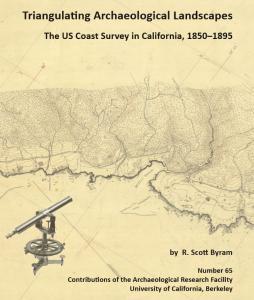Triangulating Archaeological Landscapes: The US Coast Survey in California, 1850-1895
From 1850 to 1895 the U.S. Coast Survey (USCS), known as the U.S. Coast and Geodetic Survey after 1878, generated a vast quantity of manuscript records depicting many significant archaeological and historical sites, often detailing landscape settings. In their efforts to plot nearby landmarks as references for future surveyors to relocate survey markers, they mapped and described shell mounds, caves and trails, embarcaderos and harbors, and innumerable structures ranging from bark lodges, earthworks, and adobe ruins to nascent city blocks. Yet most of the records generated by these scientists have not been considered by archaeologists.
This volume presents examples of the more distinctive records in the USCS collection. Although growing in importance for ecological research in this region, the US Coast Survey records have yet to find their place as baseline data for archaeological research in California. There are hundreds of unpublished 19 th century maps, field notebook pages and sketches in the USCS archives that depict many significant archaeological sites. The records cover the entire shoreline and tidewater reaches of the California, as well as shorelines of Baja California and the Northwest Coast.
The USCS surveyors preceded archaeologists by decades at several sites, documenting topography, historical associations, and period context. In light of later archaeological and historical studies these records can greatly enhance interpretations of site structure and other variability. This volume examines several California sites the USCS documented with maps, descriptions, and/or drawings. It demonstrates how USCS maps and location descriptions allow the archaeologist to confirm and characterize previously identified sites and features, to locate sites and features that are reported but not yet confirmed, and to identify new sites or site components. They provide additional data for interpretations of sites based on other archival sources, oral history, and archaeological data. These records expand our understanding of site context with detailed topography, vegetation cover, and infrastructure development at set points in time. And because surveyors were primarily interested in describing settings for later relocation of survey markers, their descriptions of settings often portray details that may not be evident in many other types of records, such as the use of a particular building, or the ethnicity of people living at or near a mapped location. Unlike many graphic portrayals of the era, USCS maps and sketches are rarely embellished, having a strong emphasis on structures and other physical infrastructure such as roads, fences and water sources. These characteristics leave USCS records well suited to incorporation in archaeological analysis.






